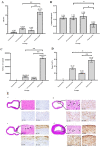Anti-inflammation-based treatment of atherosclerosis using Gliclazide-loaded biomimetic nanoghosts
- PMID: 37620556
- PMCID: PMC10449813
- DOI: 10.1038/s41598-023-41136-y
Anti-inflammation-based treatment of atherosclerosis using Gliclazide-loaded biomimetic nanoghosts
Abstract
In the study, a biomimetic platform for anti-inflammatory-based treatment of atherosclerotic plaque was developed. Gliclazide (GL) as an anti-inflammasome agent was encapsulated in PLGA nanoparticles (NP), which were coated by monocyte membrane using an extrusion procedure. The size and zeta potential of the nanoghost (NG) changed to 292 and - 10 nm from 189.5 to -34.1 in the core NP. In addition, the actual size of 62.5 nm with a coating layer of 5 nm was measured using TEM. The NG was also showed a sustained release profile with the drug loading content of about 4.7%. Beside to attenuated TNFα, decrease in gene expression levels of NLRP3, MyD88, NOS, IL-1β, IL-18 and caspases 1/3/8/9 in LPS-primed monocytes exposed to NG strongly indicated remarkable inflammation control. After systemic toxicity evaluation and pharmacokinetic analysis of NP and NG, intravenous NG treatment of rabbits with experimentally induced atherosclerosis revealed remarkably less plaque lesions, foam cells, lipid-laden macrophages, and pathological issues in tunica media of aorta sections. Higher expression of CD163 than CD68 in aorta of NG-treated rabbits strongly reveals higher M2/M1 macrophage polarization. The bio/hemocompatible, biomimetic and anti-inflammatory NG can be considered as a potential platform for immunotherapy of particularly atherosclerosis in the field of personalized medicine.
© 2023. Springer Nature Limited.
Conflict of interest statement
The authors declare no competing interests.
Figures






Similar articles
-
Pro-efferocytic macrophage membrane biomimetic nanoparticles for the synergistic treatment of atherosclerosis via competition effect.J Nanobiotechnology. 2022 Dec 1;20(1):506. doi: 10.1186/s12951-022-01720-2. J Nanobiotechnology. 2022. PMID: 36456996 Free PMC article.
-
Rapamycin-Loaded Biomimetic Nanoparticles Reverse Vascular Inflammation.Circ Res. 2020 Jan 3;126(1):25-37. doi: 10.1161/CIRCRESAHA.119.315185. Epub 2019 Oct 24. Circ Res. 2020. PMID: 31647755
-
Gliclazide alters macrophages polarization state in diabetic atherosclerosis in vitro via blocking AGE-RAGE/TLR4-reactive oxygen species-activated NF-kβ nexus.Eur J Pharmacol. 2021 Mar 5;894:173874. doi: 10.1016/j.ejphar.2021.173874. Epub 2021 Jan 15. Eur J Pharmacol. 2021. PMID: 33460615
-
Targeting foam cell formation and macrophage polarization in atherosclerosis: The Therapeutic potential of rhubarb.Biomed Pharmacother. 2020 Sep;129:110433. doi: 10.1016/j.biopha.2020.110433. Epub 2020 Jun 28. Biomed Pharmacother. 2020. PMID: 32768936 Review.
-
Monocyte fate in atherosclerosis.Arterioscler Thromb Vasc Biol. 2015 Feb;35(2):272-9. doi: 10.1161/ATVBAHA.114.303565. Epub 2014 Dec 23. Arterioscler Thromb Vasc Biol. 2015. PMID: 25538208 Review.
Cited by
-
Recent Applications of PLGA in Drug Delivery Systems.Polymers (Basel). 2024 Sep 14;16(18):2606. doi: 10.3390/polym16182606. Polymers (Basel). 2024. PMID: 39339068 Free PMC article. Review.
-
Nanoparticle-Based Immunotherapy for Reversing T-Cell Exhaustion.Int J Mol Sci. 2024 Jan 23;25(3):1396. doi: 10.3390/ijms25031396. Int J Mol Sci. 2024. PMID: 38338674 Free PMC article. Review.
-
Comprehensive Ocular and Systemic Safety Evaluation of Polysialic Acid-Decorated Immune Modulating Therapeutic Nanoparticles (PolySia-NPs) to Support Entry into First-in-Human Clinical Trials.Pharmaceuticals (Basel). 2024 Apr 9;17(4):481. doi: 10.3390/ph17040481. Pharmaceuticals (Basel). 2024. PMID: 38675441 Free PMC article.
-
Extraction, Isolation, and Component Analysis of Turmeric-Derived Exosome-like Nanoparticles.Bioengineering (Basel). 2023 Oct 15;10(10):1199. doi: 10.3390/bioengineering10101199. Bioengineering (Basel). 2023. PMID: 37892929 Free PMC article.
-
The Anti-Inflammatory Effect of Lactococcus lactis-Ling-Zhi 8 on Ameliorating Atherosclerosis and Nonalcoholic Fatty Liver in High-Fat Diet Rabbits.Int J Mol Sci. 2024 Oct 20;25(20):11278. doi: 10.3390/ijms252011278. Int J Mol Sci. 2024. PMID: 39457059 Free PMC article.
References
Publication types
MeSH terms
Substances
LinkOut - more resources
Full Text Sources
Medical
Research Materials
Miscellaneous

